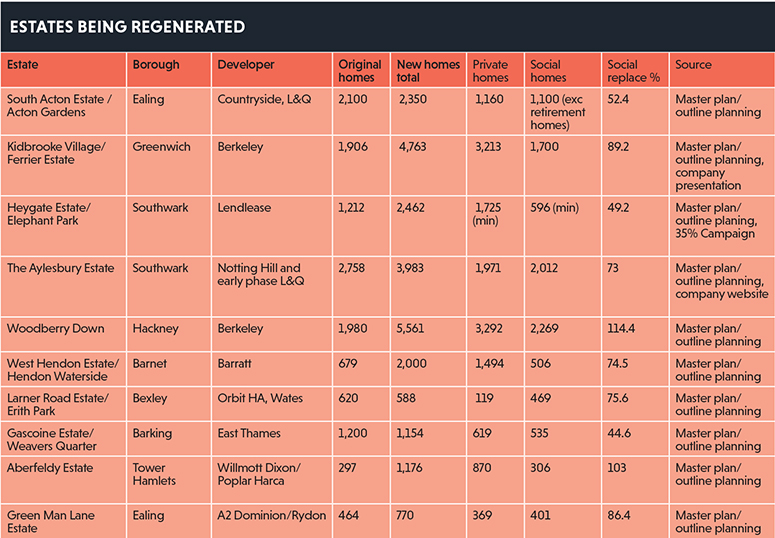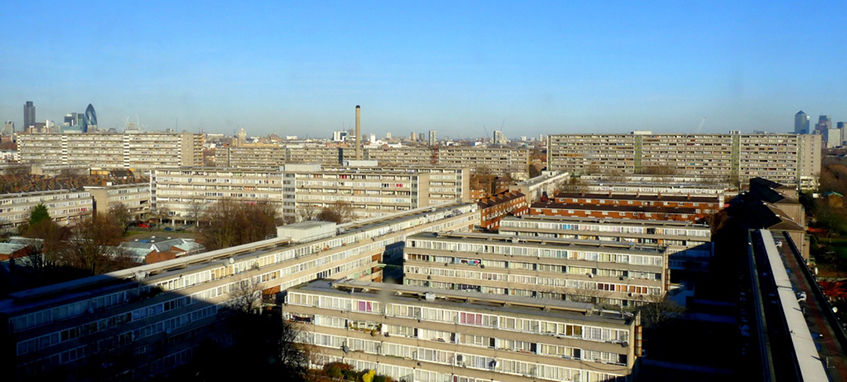A quarter of social homes demolished during estate regeneration projects in London are not replaced, according to new EG data.
Analysis of 10 of the largest estate regeneration projects in the capital found that of the 13,216 council homes that were demolished in the past five years, there were 9,890 social replacements – or 74.8%.
As hundreds of residents marched on Haringey Town Hall last week protesting against the council’s jv with Lendlease, concerned at social cleansing and the loss of their homes, the percentage presents a bleak picture.
There are caveats within the figures as many of the homes that were demolished had been sold through Right-to-Buy. However, the number of affordable homes that are stated to have been replaced is also debatable.
Many residents’ groups have expressed concern at the “affordability” of shared ownership or intermediate rent homes that make up the replacements.
Green London Assembly member Sian Berry says the figures are a travesty and show that social cleansing in London is all too real.
“Not only should every home knocked down be replaced at the same rent and tenure, but any project should add many more social rented homes to our city,” she says. “Involving residents in making these plans would see much better results.”
Haringey Council approved its £2bn development vehicle with Lendlease, despite opponents claiming it was a bad deal and being accused of “creating a financial crisis in the homes of the most deprived”.
“It is very difficult to replace affordable housing on a one-for-one basis, because affordable housing requires a subsidy. You have to mix the tenure to get anywhere close to replace the affordable provision on schemes.”
But there are many facets to estate regeneration and councils have found themselves in difficult situations with few options to regenerate some of their most deprived areas. There is little or no funding for estate regeneration and few options for redevelopment.
The previous administration’s £32m estate regeneration fund for the 100 worst sink estates worked out at just £320,000 per estate.
As a result, councils have turned to the private sector for redevelopment, which, in turn, needs to make estate regeneration financially viable.
One estate regeneration expert, who asked not be named, says: “The obvious issue is viability. You tend to find that when these things are represented to the market, they have to attract a pool of developers and to do that they have to make the commercial package look as attractive as possible, while balancing against their statutory obligations.
“To make it attractive to even one party you need to balance the commercial demands with the commercial reality.”
Simon Chatfield, director at developer Be Living, says: “It is very difficult to replace affordable housing on a one-for-one basis, because affordable housing requires a subsidy. You have to mix the tenure to get anywhere close to replace the affordable provision on schemes.”
EG’s research found the number of homes on estates has increased by 87.7%, with 23,569 homes built to the 13,216 demolished.
Increasing the density allows for the economic viability of schemes to increase. But while densification helps solve the overall numbers game of the housing crisis, it does not help the social housing crisis.
Social homes as a percentage of total new homes were just 39.9%. And just two of the estate measured increased the original number of affordable units on site, while two replaced less than 50% of their affordable housing.
Jerry Flynn, of the 35% Campaign, which was strongly opposed to the development agreements around the Heygate and Aylesbury Estates in Southwark, says it is a case of developer greed.
“It’s their business: it’s the development business to make as much as money as they possibly can. You present them with an opportunity to make money and they will take advantage.”
On its website, the 35% Campaign says just 82 homes in the redevelopment of the Heygate Estate in Elephant & Castle are genuinely affordable at social rent levels.
The GLA’s 2015 report into estate regeneration said 30,431 social rented units had been demolished as part of estate regeneration, but were replaced with just 22,135 – a 27% decline.
Flynn does not think local authorities are a match for developers, and says if they are going to enter into deals, they need to do the best they can in exchange for the land and planning permission.
Against this, there are advantages to private sector development: mixed-tenure estates can avoid the problems that beset sink estates in the past and their virtual separation from the wider community.
At the same time, accusations of social cleansing are far from unjustified and there are sometimes doubts towards segregation in schemes.
While many now incorporate affordable housing across the development in a tenure blind fashion, this is not always the case.
“I am not sure that the communities are any more mixed, they are more segregated,” says Flynn. He points out the separation of social blocks for management purposes, “poor doors” and separate cores do not create mixed communities. Nor does he think they do much to break down the monoculture of existing estates.
It is also difficult to keep track of what is promised and what is delivered – with total unit numbers, total affordable replacements and the breakdown of tenures hard to find and rarely clearly disclosed. After outline applications, schemes are phased and percentages can change. Variations to planning are often decided by an officer, not committee.
Due to these complications, EG’s research used only outline planning numbers for consistency.
The GLA declined to comment on its approach to estate regeneration as it is says it is still in the process of reviewing it. But in its draft good practice guidelines issued in December last year it said: “The mayor believes that for estate regeneration to be a success, there must be resident support for proposals, based on full and transparent consultation.
“These proposals should offer full rights to return for displaced tenants and a fair deal for leaseholders, and demolition should only be followed where it does not result in a loss of social housing, or where all other options have been exhausted.”
As a number of new large-scale estate regeneration projects get under way, in Wandsworth, Haringey and Havering, it will be the challenge for councils and developers to keep local residents onside.
“You have to get the existing community onside in the first instance – listen to their concerns and do your best to address them,” says Chatfield.
“The best way to approach that is with honesty at the beginning.”
But councils are becoming more cautious. Most, if not all, of the new regen schemes will have 100% like-for-like replacements of affordable housing written into their contracts, in part because the booming London market can replace them, because densification is becoming more acceptable and because councils are becoming more savvy.

To send feedback, e-mail alex.peace@egi.co.uk or tweet @egalexpeace or @estatesgazette











